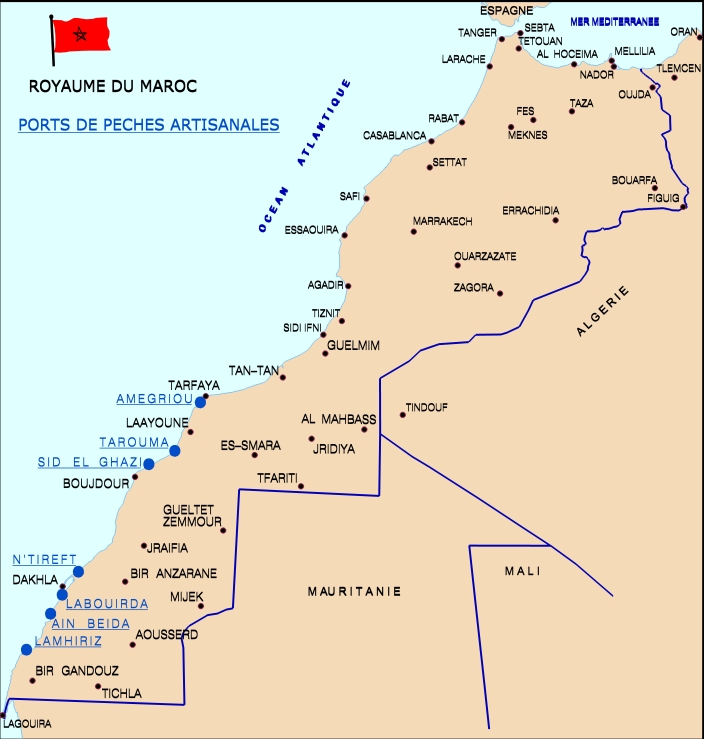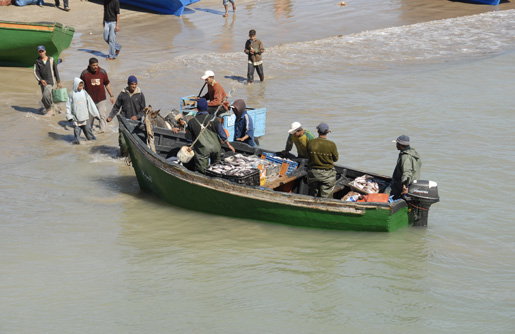
I. SECTOR SITUATION AT The RECOVERY OF The SAHARA REGION
The Sahara region, recovered in 1975, extends over about 1.100 kilometers of coasts on a surface of continental platform of 55.100 km².
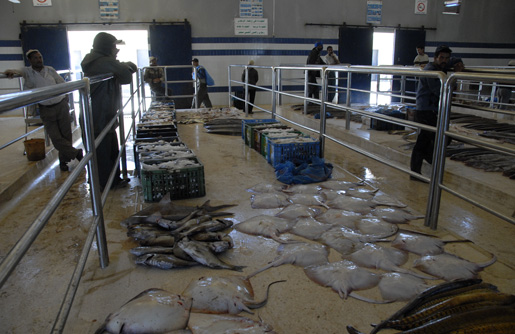
It is characterized by the abundance and diversity of halieutic resources found in its maritime spaces. The resources of small pelagic are the main exploitable component of the global biomass at the level of this zone.
In addition to pelagic resources, we also find demersal resources which are mainly represented by cephalopods, sparus and large shellfish.
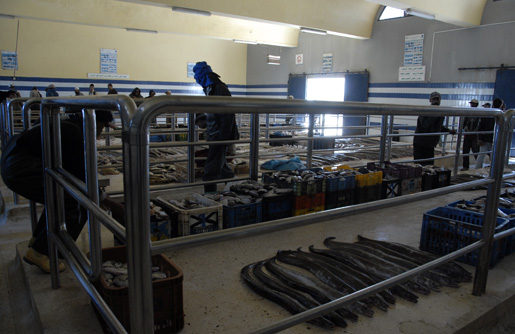
However, in spite of this halieutic richness, no exploitation was carried out in this region except for a foreign pirate fleet which operated apart from any lawful framework.
This zone was also characterized by the quasi-total absence of any infrastructure and superstructure likely to support the exploitation of this halieutic inheritance under appropriate conditions.
In this respect, since the recovery by the Kingdom of Morocco of its southern provinces, the will to set up the maritime fisheries sector as a strategic axis of economic and social development in the region was concretized by the setting up of investments specialized in fishing fleet and valorization industries by private sector and reception and training infrastructure as far as the public sector is concerned.
Achievements in the field
- Fishing Fleet:
The fishing fleet registered in the ports of the Sahara region is composed as follows:
- Fishing on the seas: 17 ships;
- Inshore fishing: 173 units;
-- Fisherfolks: 5,866 canoes.
The estimated total investment injected into the fishing fleet registered in the area since 1977 amounted to 1,445 million MAD and, allocated as follows:
- High sea fleet: 510 million
- Coastal fleet: 700 million
- craft Fleet: 235 million
- Landing Infrastructure
. landing Ports
The zone’s landing facilities consist of 2 major ports located in Laayoune and Dakhla. A 3rd fishing port is under construction in Boujdour. It should be noted that the new port of Dakhla has enabled the redeployment of part of the fleet which benefits from proximity to the fishing waters.
. Reception facilities of fisherfolks (fishing villages and fitted landing)
As part of the maritime sector policy to promote and organize the activity of craft fisheries, services in charge of marine fisheries have made a development program through the realization throughout the Moroccan coastline of several arranged landing points and fishing villages.
This large-scale program, is an opportunity to lay the groundwork for a policy of coastal development, based on the introduction of new regional development micro-poles to improve the socio-economic conditions of fishermen.
In this regard, these facilities were conducted in 11 fishing sites in the Sahara region including:
• Amégriou and Tarouma in the province of Laayoune;
• Sidi El Ghazi Lekraa in the province of Boujdour;
• N'tirift and Labouirda in the province of Oued Eddahab;
• Lamhiriz in the province of Aousserd;
• Aftisset (Cap 7) in the Boujdour province;
• Ain baida, Imoutlane and Lassarga in the province of Oued Eddahab.
At these sites, basic infrastructure, social collective equipment, fish halls and administrative buildings have been completed. The total cost of investment for the implementation and management of these sites amounts to 915 million MAD with funding divided between Hassan II Fund, the Agency for the South and the National Office of Fisheries.
- Fishing Industry
The analysis of the integration of marine fisheries sector in the economy of the Sahara region shows that, until early 1990, this activity had as major socio-economic impact on the southern region the activity of fishery landings.
Indeed, given the absence of industrial facilities, the owners of the coastal fishing fleet had no other alternative than to deliver their catch to the northern factories (Agadir, Essaouira and Safi).
Faced with this situation, tax and land facilities and incentives were granted to operators to encourage them invest in a recovery industry. Marine fishery sector has registered investment ashore in relation to recovery and processing of fishery products.
In the first stage, it is the manufacturers of flour and fish oil that emerged in Laayoune (9 units for an investment of more than 63 million MAD), followed by units of frozen octopus respectively in Dakhla and Laâyoune.
It is through the development of the fishing industry conducted primarily by dynamic cephalopod fishery that the freezing industry has seen a gradual and sustained development since 1994 in Dakhla and then since 1998 in Laayoune.
Therefore, the number of freezing units in Dakhla moved from 4 in 1994 to 84 in 2006, making of freezing one of the main attractions in the region. In Laâyoune, freezing activity grew later, in 1998, following a trend as stronger as Dakhla’s since the number of approved units increased from 5 to 30 between 1998 and 2006.
Details of the investment and processing of seafood per year for every port are given later.
- Marketing Infrastructure:
Major marketing and fishery facilities relating to products amounting to about 100 million MAD, namely fish halls and structures needed for ancillary activities (shops fishermen, fish shops, ice plants, cold rooms, etc ...) have been conducted in the Sahara region.
Also, 3 fish halls were built at the fishing ports of Laayoune, Boujdour and Dakhla, as well as commercial centers at the sites of the craft fisheries of Agti and Ghazi el Lakraa (Boujdour Province), N'Tireft, Lassarga and Labouirda (Oued Eddahab province), Lamhiriz (Aousserd province).
Resource Preservation and exploitation
-Management and Development of fisheries
. Development of cephalopod fishery
The Kingdom of Morocco has made a considerable financial effort by guaranteeing loans and encouraging investments for the acquisition of a specialized fleet.
However, the decline of the fleet was initiated in 1986 and completed in 1992, with entry into service of new ports in the region and the simplification of administrative procedures.
In addition, craft fishing in the Sahara region was limited until 1989 to the operation of lobster and white fish. Octopus Fishing has developed since early 1990 in an anarchic way in precarious fishing sites.
Efforts by the Kingdom of Morocco for the organization and socio-professional promotion of this activity led to the creation of fishing centers organized as a micro-poles of development. The coastal cephalopod trawling in the southern Atlantic is an activity that has grown since the mid 80's. The opening of the ports of Tan-Tan and Laâyoune has promoted the development of this type of fishing in the South Atlantic zone.
In order to ensure a rational and sustainable exploitation of this fishery, Guardianship Services have established a specific plan which guarantees the sustainability of resources and the consolidation of investment in the fishery sector.
. Pelagic Resources
The Sahara region holds a large stock of pelagic resources initially operated by foreign fleets outside any regulatory framework, the small pelagic fishery in this region has begun its formal operation in early 80 with the activity of Soviet vessels operating under an agreement between the Kingdom of Morocco and the Soviet Union.
The second step in the evolution of the exploitation of this fishery was inaugurated by the Kingdom of Morocco late 90 with the setting up of a charter for the benefit of national operators.
The opening of Laayoune port enabled the national coastal fishing fleet accede to the fishery and initiate investment and valorisation of these species.
Aware of the weakness of the socio-economic modus operandi by the charter, the management of marine fisheries have set up, in conjunction with operators, a development plan for this fishery concerning the promotion of sectors with high added value which can contribute to the creation of wealth for the benefit of the local economy in the regions concerned.
Thus, in order to implement provisions of the development plan and as part of the conversion programme of freezing units agreeing to abandon octopus treatment, a quota of 300,000 tonnes was allocated to industries in Dakhla and Laâyoune.
A substantial catch quota has been allocated to promoters in the Sahara region in order to ensure the viability of their investment in the freezing field.
The development plan for this fishery is currently being adopted by the competent Department after having been through a long consultation process.
. Other resources
Other fishery resources in the region are subjected to exploitation by coastal fleets and local craft. In addition, the possibilities for developing aquaculture and coastal activities are expected at the bay of Dakhla.
Scientific Research
In order to strengthen the capacity of fisheries research in the Sahara region, the National Institute for Fisheries Research (INRH) proceeded with the construction and equipment of two regional centres in Laayoune and Dakhla, including laboratories, administrations, a canteen, studios and annexes.
- INRH Regional Center in Laayoune
The center which opened in 1998 covers the souther Atlantic sea area(Sakiat Al Hamra eddahab-Oued). It has an area of 6,000 square metres, 1,650 sq metres of which are built. The center building cost amounts to 14,350 million including 8.77 million MAD spent on the construction and 5.58 million to scientific equipment.
Major research axes concern:
• Pelagic fishery
• Demersal fishery
• Socioeconomics
• Craft and longline fishery
• Monitoring coastal hygiene
- INRH Regional Center in Dakhla
It covers the Oued Eddahab-Lagouira sea area. It was completed in 1997 with a total area of 16,179 sq. m. 1,402 sq.m of which are built. The centre building cost amounts to 15 million including 8 million spent on the construction and 7 million in scientific equipment.
Major research center axes concern:
• Evaluation of fishery resources
• Monitoring the quality and safety of the marine environment
• Oceanographic studies and coastal resources
- INRH Research Campaigns in the Sahara Region
Oceanographic research and evaluation campaigns of the various resources of the Sahara region conducted annually by the National Institute of Fisheries Research through its research vessels amount to over 10 million MAD.
- Surveillance and Control
The resources required in terms of fishing monitoring and control, allocated by the departments in charge of sea fishing allow accompany the sound management of fishery resources.
The control system implemented aims to prevent, deter and eliminate illegal fishing and gradual eradication of the informal sector. It covers the following areas:
• Monitoring of vessels, engines, techniques, areas and fishing times;
• Compliance with safety standards for fishing vessels, and conditions of access to fishing grounds;
• Control the quantities and caught sizes;
• Monitoring product traceability;
• Control of products on the market (market size, origin).
The Sahara region is the most targeted the Kingdom’s efforts relating to the control and surveillance taking the importance of the fishing activity. The audit requires physical facilities and human resources, including monitoring at sea and on land which use vessels, vehicles and surveillance personnel with specific equipment (equipment for sampling, surveying, and remote communication).
Indeed, the control concerns all activities in the fisheries sector, from fishing operations (fishing zones, fishing and networking engines, species) to the commercialisation (traceability) through registration activities (reporting of catches, logbook), landing (market size, quota), transport and storage of fishery products.
Thus, as presented below, the emphasis has been placed on the acquisition of the means for air and land monitoring in addition to the reinforcement of personnel and training of inspectors:
• Acquisition since 1990 of 14 sea monitoring planes at a total cost of 286.5 million MAD.
• Acquisition since 1996 of a monitoring system of activities of fishing vessels at sea by satellite with an investment of more than 70.9 million MAD.
• Allocation of human resources and material resources and vehicles 8 million MAD.
• Support to the improvement of craft fisheries, contribution to the fight against informal sector and re-registration of fishing boats. This operation was launched in the Sahara region in November 1999 until late 2002 with an amount of 3 million MAD.
- Fishery Production in the Sahara Region
Map illustrating Fishery Production


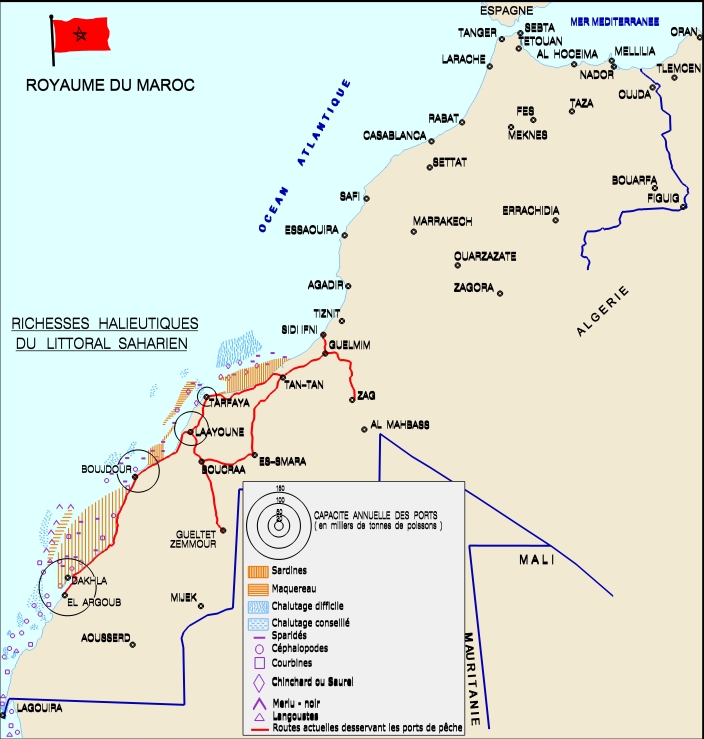
Source : Sahara marocain - Intégration et développement
- Production Coastal Fishing Fleet
The coastal fleet in the ports of the Sahara region is estimated at about 170 seiners, 300 trawlers that operate primarily during the opening of octopus fishing and 20 longliners.
in addition, there are 5000 craft boats including 90% concentrated in the regions of Boujdour and Dakhla. Dakhla craft boats target octopus and demersal fish.
. Total Production (weight in tonnes)

The table shows that Laayoune port contributes by more than 89% in fish production in the region and 43% in terms of value. That position goes to the port of Laayoune thanks to the production of pelagic fish. It is considered among the major producer ports nationwide.
. Production of pelagic fish (weight in tonnes)

It is clear from these indicators that small pelagic fishing 88% of inputs of the coastal fleet operating in the Sahara region.
The pelagic production at the ports listed above showed a slight decrease in weight due mainly to the decrease in production at the port of Laayoune.
. Production of white fish (weight tonnes)

The landing of white fish in the region is weak in terms of weight, these species represent only 7% in the overall weight registered in 2006.
. Production of cephalopods (weight in tonnes)

Ashore Industry and Product Destination
- Ashore Industry
Sea fishing activity is accompanied by a processing industry onshore consisting of valorisation, freezing and processing units as well as fish meal units. The number of fish processing institutions in the Sahara region is as follows:

Destination of Fishery Coastal Products (2005)

In addition to the volumes for these channels, a part of catches is destined for consumption. The table shows that the fishmeal sector remains overwhelming in comparison with other destinations.
Although the city of Dakhla has an important freezing industry, the volumes handled by these plants are weak given the specialization of the industry in the treatment of octopus whose catches have declined sharply in recent years.
The volumes of small pelagic fishing from C stock are generally intended for freezing or fishmeal.
Employment in Marine Fisheries
The fishing activity in the region creates around 20,000 indirect jobs, 11,500 jobs aboard coastal ships and about 40,000 created by the activities of craft fisheries.
These data highlight the importance and role of the fisheries sector as a development incentive in the Sahara region.
Maritime Training and Socio-professional Promotion
The human element is an important component of the program for the development of marine fisheries sector in the region of the Sahara.
In order to contribute to developing the skills and leadership in the field of marine fisheries in the Sahara region, two maritime training institutes have been created in these provinces:
- Institute of Fisheries Technology (ITPM) in Laayoune, founded in 1984 as a Professional Qualification Centre and Maritime set up in 2005. It should be noted that prior to 2001, when new locals in the Laayoune institution were built, training was provided in buildings made available by the Office of Vocational Training and Job Promotion.
- Center for Professional Maritime Qualification in Dakhla (CQPM) created in 2001.
The cost of achieving these two institutions (construction and equipment) amounted to 47 million MAD.
Laayoune ITPM owns School Arrachid II Ship acquired as part of the Moroccan-Japanese cooperation. It is a trawler of 19.15 m length used to train interns. Its cost amounts to 10 million MAD.
In order to carry out their proximity actions, these schools have space for training in Boujdour and three mobile units, including two based in Laayoune and Dakhla, for a total cost of 1 million MAD.
In terms of training, the overall number of staff trained by the 2 maritime training institutes based in the Sahara region, i.e. the Technological Institute of Maritime Fisheries in Laayoune and the Centre for Professional Maritime Qualification in Dakhla amounted to 709 people including all training methods (Residential, Learning).
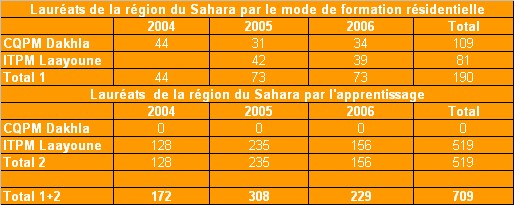
In terms of career promotion, the actions carried out during the same period covered 16,860 beneficiaries including 1,125 in continuing training, 15,650 in functional literacy and 85 in extension.

In the context of social promotion, 2 clinics were created in the Sahara region in Laayoune and Tarfaya.
Regarding the rescue of human life at sea, the Sahara region has 2 motor boats and 2 lifeboats with a total cost of 31.8 MDH. A boat and a canoe will be redeployed shortly respectively in the port of Tarfaya and Cap 7 fishing village in Boujdour. Another is being acquired for the port of Boujdour with the amount of 15 million MAD.
The number of registered fishermen operating in the maritime region of the Sahara are 7237 people.
Infrastructure and Human Resources of the Departments in charge of Marine Fisheries
Shipping performances are managed by 145 people divided as follows:
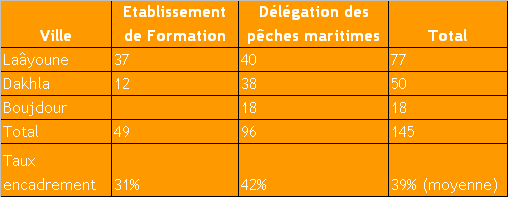
During the last 2 years, 25 recruits were carried out in the Sahara region, i.e. over 70% of recruitments during this period. 50% of recruits are fishery and food engineers while the other 50% are profiles tailored to the Maritime Administration.
It is planned in 2007 to strengthen maritime services in the region of the Sahara by the recruitment of 12 engineers, representing 100% of expected recruitment.
The administrative coverage in the Sahara region is ensured by 3 Delegations in Laayoune, Boujdour and Dhakhla, 7 sub-delegations in Tarfaya, Akti Lghazi and Lakraa, Ntireft, Foum El Bir, Punta Chica and Lamhiriz and two maritime training institutes in Laayoune and Dakhla.
Fishery Infrastructure
Several socio-professional projects have emerged in the Sahara region in recent years. They are either under development or in the completion process including:
. Landing equipped Point (PDA)in Amégriou:
Target population: 250 fishermen
Amount: 14.5 million MAD
Completion date: 2005
Currently, PDA profits from partnership with the Development Agency of Southern Provinces to carry out, among other things the access road (progress rate 50%)
. Extension of the Laayoune Delegation of Fisheries
Amount: 4 million MAD
Completion date: 2008
. Extension of the Dakhla Delegation of Fisheries
Amount: 1.6 Million MAD
Completion date: 2008
. Concerning equipment, vehicle fleet has been strengthened by providing the Sahara region with:
Laâyoune: 6 vehicles and 1 mini bus for staff
Boujdour: 2 vehicles
Dakhla: 6 vehicles
The table below shows investments carried out in the fishing sector by the Kingdom of Morocco in the Sahara since 1975:
|
Nature |
|
Détail |
Montant en dh |
|
Constructions Administratives |
Antenne médicale |
Antennes médicles et bâtiment Administratif |
1 475 751 |
|
|
Aménagement A.M. |
160 000 |
|
|
Construction A.M. |
250 000 |
|
|
Total AM |
|
1 885 751 |
|
|
Délégations et sous délégation |
Construction DPM |
10 741 075 |
|
|
Construction DRAM |
899 422 |
|
|
Extension DPM |
3 916 846 |
|
|
Logement Fonction |
875 000 |
|
|
Total DPM |
|
16 432 343 |
|
Total Constructions Administratives |
|
18 318 094 |
|
Équipements |
|
Équipements |
5 038 424 |
|
|
|
Véhicules |
7 259 000 |
|
Total Équipements |
|
|
12 297 424 |
|
Formation maritime |
|
Construction EFM (financés clé en mains par l'équipement) |
21 000 000 |
|
|
|
Subvention d'équipement aux EFM |
26 700 000 |
|
Total Formation maritime |
|
|
47 700 000 |
|
Programme National de l'Aménagement du Littoral (PNAL) |
|
Construction PDA Amegriou |
14 812 020 |
|
Total PNAL |
|
|
14 812 020 |
|
Sauvetage maritime |
|
Vedettes et canots de sauvetage |
31 450 695 |
|
Total Sauvetage maritime |
|
|
31 450 695 |
|
Surveillance maritime |
|
Surveillance des bateaux de pêche par satellite |
70 892 862 |
|
|
|
14 Avions de Surveillance |
286 500 000 |
|
Total Surveillance maritime |
|
|
357 392 862 |
|
|
|
|
|
|
Total des investissements dans la région du Sahara depuis 1975 |
481 971 095 |
Illustration Map:
